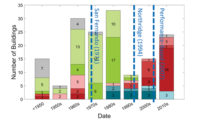To reduce seismic risk to new tall buildings, San Francisco should develop regulations to address foundation and geotechnical issues. The city also should set performance-based design standards. For existing high-rises, the city should enforce repair provisions of the building code, with respect to damage from 1989’s Loma Prieta earthquake, and amend the code to include triggers for seismic upgrades.
The advice to the city is among 16 recommendations from the nonprofit Applied Technology Council. The wishlist is summarized in ATC’s Tall Buildings Safety Strategy report, issued by San Francisco on Oct. 4.
“We know an earthquake is coming,” says the report. “The U.S. Geological Survey estimates there is a 72% chance of a magnitude 6.7 or greater earthquake before 2043.”
The city commissioned the $400,000 study, which it says is the first of its kind in the U.S. The study is part of the city’s 30-year Earthquake Safety Implementation Program (ESIP).
ESIP, launched in 2012, has 50 tasks. One is to address the likely failure of larger “soft-story” apartment buildings, which have on-grade parking beneath an elevated first floor.
“We have a long history of programs to address various vulnerable building types,” says Danielle Mieler, principal resilience analyst in the city’s office of resilience and capital planning. Beyond soft stories, these include unreinforced masonry, nonductile concrete buildings and single-family houses.
Within ESIP, tall buildings are singled out because of unique features that include difficult exterior access, multiple tenants and uses within a building, and sheer size, which complicates evaluation and retrofit.
The 14-month tall-building study, developed with input from local stakeholders, is based on 156 high-rises 240 ft or taller, primarily in the city’s northeast section. The document contains wide-ranging recommendations and a timeline for their implementation, either short-, mid- or long-term, says Ayse Hortacsu, ATC’s director of projects.
For example, the report advises the city to update and amend its code for existing buildings, to develop new policies and procedures to implement the state’s safety assessment program, and to maintain and expand its database of tall buildings.
One recommendation is to develop a comprehensive recovery plan for the financial district and adjacent neighborhoods. “If you read between the lines, you see the idea of ‘functional recovery,’ which goes beyond life safety and takes into account commerce, tourism” and more, says David Bonowitz, a structural engineer on the 13-member ATC study team.
ATC will present more details of its findings to the city early next month. The city plans to review the recommendations and issue its own implementation strategies, says Mieler.
There are no price tags attached to the ATC recommendations. The city’s eventual action plan will be based on political will and cost, she adds.
“The recommendations are built on best practices from the U.S. and around the world,” says Bonowitz. “We plan to share this work with other cities globally with similar geologic and seismic conditions.”
Bonowitz adds, “I am excited but ... nothing is going to change overnight.”





Post a comment to this article
Report Abusive Comment